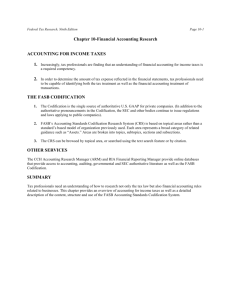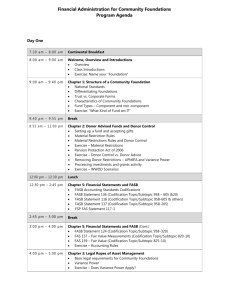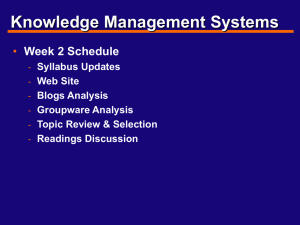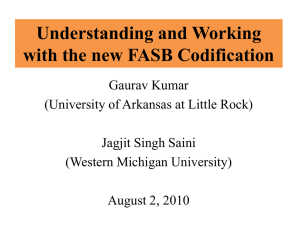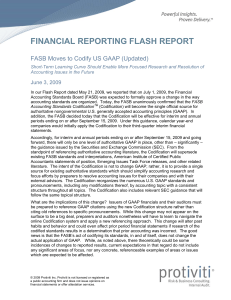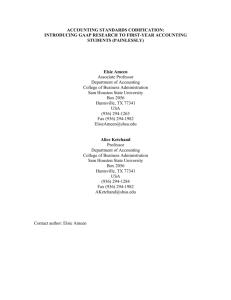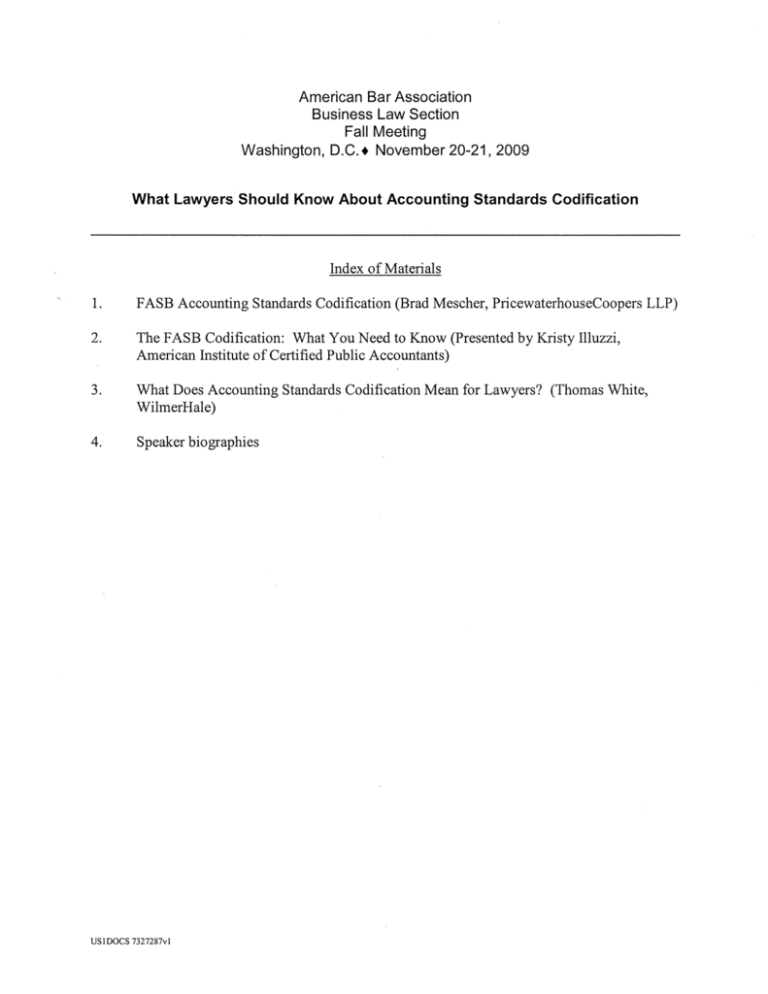
American Bar Association
Business Law Section
Fall Meeting
Washington, D.C. + November 20-21,2009
What Lawyers Should Know About Accounting Standards Codification
Index of Materials
1.
FASB Accounting Standards Codification (Brad Mescher, PricewaterhouseCoopers LLP)
2.
The FASB Codification: What You Need to Know (Presented by Kristy Illuzzi,
American Institute of Certified Public Accountants)
3.
What Does Accounting Standards Codification Mean for Lawyers? (Thomas White,
WilmerHale)
4.
Speaker biographies
ABA Conference
FASB Accounting Standards Codification
Brad Mescher – Director
National Professional Services Group
PricewaterhouseCoopers LLP
Agenda
• Overview
• Pre-Codification literature
• What exactly is included?
• What are the benefits?
• Codification structure and referencing
• How will the FASB update the Codification?
• Referencing the Codification in financial statements and future
filings
• SEC Staff Views: Center for Audit Quality Alert 2009-76
• Implementation and other practical considerations
• What tools are available?
PricewaterhouseCoopers LLP
November 2009
Slide 2
Overview
•
Multi-year project undertaken by the FASB to develop a single authoritative
source of US GAAP for nongovernmental entities
–
On-line repository and search system that integrates and categorizes existing US
GAAP for nongovernmental entities
–
Two levels of US GAAP – authoritative and nonauthoritative
•
New organization structure and referencing of US GAAP
•
Not intended to change US GAAP; however, Codification affects the way
companies reference US GAAP in their financial statements and in their
accounting policies
•
Effective for financial statements that cover interim and annual periods ending
after September 15, 2009
–
Calendar year-end public companies were required to apply Codification to their
September 30, 2009, third-quarter, interim financial statements.
PricewaterhouseCoopers LLP
November 2009
Slide 3
Pre-Codification literature
FASB Statements
FASB Staff Positions
Accounting Principles Board Opinions
FASB Technical Bulletins
AICPA Audit and Accounting Guides
EITF Appendix D
Accounting Research Bulletins
AICPA Statements of Position
EITF Abstracts (and issue summaries)
AICPA Practice Bulletins
AICPA Technical Questions and Answers
FASB Concepts Statements
SEC S-X Rules
FASB Interpretations
FASB Staff Implementation Guidance
AICPA Audit Risk Alerts
AICPA Accounting Interpretations
SEC S-K Items
SEC SAB Codification Topics
AICPA Issues Papers
SEC Speeches—Topics Covered
SEC ASR / FRR Codification Sections
Note: Not all of the above were level A-D GAAP and, therefore, some are not in the FASB Accounting Standards Codification.
PricewaterhouseCoopers LLP
November 2009
Slide 4
What exactly is included?
•
•
Codification includes all guidance by standard setters
•
FASB – Statements, Interpretations, Technical Bulletins, Staff Positions, Staff Imp. Guides
•
Emerging Issues Task Force – Abstracts and Topic D
•
Derivative Implementation Group (DIG) Issues
•
Accounting Principles Board Opinions
•
Accounting Research Bulletins
•
Accounting Interpretations
•
AICPA – Statements of Positions, incremental accounting guidance from Audit and
Accounting Guides, Practice Bulletins, and Technical Inquiry Service Q&As (only for software
revenue recognition)
Reprints of selected content issued by the SEC or the SEC staff
•
Regulation S-X
•
Financial Reporting Releases/Accounting Series Releases
•
Interpretative Releases
•
SEC Staff Guidance in Staff Accounting Bulletins, EITF Topic D and SEC Staff Observer
Comments made at meetings of the EITF
PricewaterhouseCoopers LLP
November 2009
Slide 5
What are the benefits?
• All authoritative guidance in one place
• Existing guidance can be updated and new guidance can be
incorporated by topical area rather than by standard type
• Able to select a topic and ensure that you are accessing all
information relevant to that topic
PricewaterhouseCoopers LLP
November 2009
Slide 6
Codification structure and referencing
The Codification is organized into:
• Areas
• Topics
• Subtopics
• Sections
• Subsections
• Paragraphs
PricewaterhouseCoopers LLP
November 2009
Slide 7
Codification structure and referencing
First, there are Areas and Topics…the Codification is organized
into approximately 90 Topics that fall within five main areas.
AREAS
TOPICS
General Principles and
Objectives
Generally Accepted Accounting
Principles
Presentation
Balance Sheet, Income Statement, etc
Financial Statement Accounts
Income Taxes, Receivables, Revenue
Recognition, Inventory, Debt, etc.
(Assets, Liabilities, Equity, Revenue,
Expenses)
Broad Transactions
Consolidation, Leases, etc.
Industries
Airlines, Entertainment, Software, etc.
PricewaterhouseCoopers LLP
November 2009
Slide 8
Codification structure and referencing
Second, there are Subtopics, Sections, and Subsections
•
Topics include one or more Subtopics
Example:
•
Topic
Subtopics
Leasing
Overall, Operating Leases, Capital Leases, etc.
Subtopics are comprised of Sections
Example:
•
Subtopic
Section(s)
Overall
Scope, Recognition, Measurement, Disclosure, etc.
Sections may be further broken down into Subsections, depending on
content of each Section
Example:
Section
Subsection(s)
Recognition
General, Lessees, and Lessors
PricewaterhouseCoopers LLP
November 2009
Slide 9
Codification structure and referencing
Referencing Convention
ASC XXX-YY-ZZ-PP
- XXX = Topic
- YY = Subtopic
- ZZ = Section
Note: “S” preceding the Section number indicates SEC content
- PP = Paragraph
Observation: The referencing structure does not include
“Subsections”. It references “Paragraphs” within “Sections”.
PricewaterhouseCoopers LLP
November 2009
Slide 10
Codification structure and referencing
Structure of referencing –
For example, a sample reference for Income Taxes: ASC 740-1030-7
- ASC 740 = Income Taxes (Topic)
- ASC 740 - 10 = Overall (Subtopic)
- ASC 740 - 10 - 30 = Initial Measurement (Section)
- ASC 740 - 10 - 30 - 7 = Paragraph 7
PricewaterhouseCoopers LLP
November 2009
Slide 11
Codification structure -- illustration
PricewaterhouseCoopers LLP
November 2009
Slide 12
How will the FASB update the Codification?
•
The FASB will issue the results of standards activity as an Accounting
Standards Update numbered as Year – Sequence (such as, 2009-05)
that includes:
-
•
•
•
•
Summary and Basis for Conclusions
Codification Update Instructions
The FASB will update the Codification concurrent with the release of
a Accounting Standards Update
Proposed Accounting Standards Updates will be exposed with the
proposed Codification update instructions
The Accounting Standards Updates will not be authoritative in their
own right
Current and transitional text presented together to ensure access to
all relevant content in the same location
-
New guidance shown as Pending Text until prior guidance has been fully
implemented.
PricewaterhouseCoopers LLP
November 2009
Slide 13
Referencing the Codification in financial statements and
future filings
•
•
Once adopted, references to specific guidance should be to
the Codification
However, consider avoiding references but clearly explain
concepts in plain-English
PricewaterhouseCoopers LLP
November 2009
Slide 14
FASB Codification
Referencing the Codification in financial statements and
future filings
HOW
HAVE
COMP
ANIE
S IMP
CODI
LEME
FICAT
NTED
ION?
TH
??
E
ASC 480-10
New reference
under FASB ASC
PricewaterhouseCoopers LLP
Alternative is ‘No
citation reference’
November 2009
9
Slide 15
FASB Codification
SEC staff views: Center for Audit Quality Alert 2009-76
•
Financial Statement References Post-Codification Effective Date (Sept. 15, 2009)
Use codification references in all periods presented
•
Financial Statement References Pre-Codification Effective Date (Sept. 15, 2009)
Pre-Codification GAAP references are acceptable
May also refer to either the Codification or both the Codification and preCodification GAAP references
•
Revisions to Previously Filed Financial Statements
Not expected to be revised
•
Preferability Letters
Not required if an accounting change is in response to a newly issued update to
the Codification
•
Specific SEC rules and interpretive releases still may be referenced in financial
statements
PricewaterhouseCoopers LLP
November 2009
10
Slide 16
Implementation and other practical considerations
•
Implementation challenges:
- Structure will take time to learn.
- Old standards may be split over several of the new topics.
- Expect to spend time learning.
•
Many public companies have already implemented for quarterly reporting
and will need to implement in annual reporting. Others still need to
implement.
- GAAP hasn’t changed – the way we reference it does
- Accounting policies, procedures, and memoranda need to be updated
- Address other aspects of financial reporting such as communications and
education processes.
•
Visit the FASB website (www.asc.fasb.org)
- Become familiar with structure.
•
Determine which tool to use to access the Codification
PricewaterhouseCoopers LLP
November 2009
Slide 17
What tools are available?
•
•
•
FASB website (www.asc.fasb.org)
– Basic view
¾ No charge
¾ Limited functionality, only content
– Professional View
¾ Requires a paid subscription
¾ Provides full functionality (including joining sections and viewing
original source documents via the print screen feature)
Hardcopy version
Comperio – PwC’s tool (www.pwccomperio.com)
– Updated to include Codification
– Includes much of the same functionality as Professional View on
FASB’s website
PricewaterhouseCoopers LLP
November 2009
Slide 18
© 2009 PricewaterhouseCoopers LLP. All rights reserved. "PricewaterhouseCoopers" refers to PricewaterhouseCoopers LLP, a
Delaware limited liability partnership, or the PricewaterhouseCoopers global network or other member firms of the network each of
which is a separate and independent legal entity.
PricewaterhouseCoopers LLP
P
w
C
FASB Accounting Standards Codification
A Desk Reference Card for Securities Lawyers
Topics, Subtopics, and Sections
Paragraphs
Citation Format
The FASB Accounting Standards Codification (ASC or the "Codification") organizes nongovernmental U.S. GAAP
using a topic-based model with five main Areas consisting of 90 individual Topics. Each Topic contains at least one
Subtopic. Subtopics contain Sections, which include the actual accounting guidance. Sections are based on the nature
of the content (e.g., scope, recognition, measurement, etc.) and are standardized throughout the Codification.
Each Section includes numbered Paragraphs. Paragraph numbers start with the Section number followed by the
unique paragraph number. For example, in Section 55 the first paragraph is numbered 55-1. Paragraph numbers in the
Codification will not change going forward. New paragraphs may result in the FASB using a letter extension in order to
keep the numbering constant. For example, a new paragraph inserted between paragraphs 55-3 and 55-4 would be
numbered 55-3A.
ASC XXX-YY-ZZ-PP
XXX
YY
ZZ
PP
Citation Examples
New Authoritative Guidance
FASB Codification Website
PwC Resources
=
=
=
=
Topic
Subtopic
Section
Paragraph
ASC 210 (Topic 210, "Balance Sheet")
ASC 210-20 (Subtopic 20, "Offsetting," of Topic 210)
ASC 210-20-60 (Section 60, "Relationships," of Subtopic 210-20)
ASC 210-20-60-5 (Paragraph 60-5 of Section 210-20-60)
New authoritative U.S. GAAP will be communicated via a new FASB document called an "Accounting Standards
Update" (or "ASU" for short). As the FASB issues new guidance, both the current paragraphs and the new guidance
will be featured in the Codification until the new guidance is effective for all entities. During this transition, the
Codification will mark the new guidance as "Pending Text" and will link to the related transition guidance. When the
new guidance is effective for all entities, the previous guidance will be removed and the new guidance will remain.
The Codification is available on the FASB's website at www.asc.fasb.org. The FASB offers a basic view (with limited
functionality) and a professional view (with expanded functionality).
The Codification is available in Comperio (www.pwccomperio.com), PwC's global library of accounting literature.
Comperio includes many of the same features as the FASB's professional view, plus a demo to assist Comperio
subscribers in navigating the Codification. PwC clients and friends can obtain a free 30-day trial at
www.pwc.com/comperio.
pwc
ASC Topic List
100
105
General Pinciples
Generally Accepted Accounting Principles
200
205
210
215
220
225
230
235
250
255
260
270
272
274
275
280
Presentation
Presentation of Financial Statements
Balance Sheet
Statement of Shareholder Equity
Comprehensive Income
Income Statement
Statement of Cash Flows
Notes to Financial Statements
Accounting Changes and Error Corrections
Changing Prices
Earnings Per Share
Interim Reporting
Limited Liability Entities
Personal Financial Statements
Risks and Uncertainties
Segment Reporting
300
305
310
320
323
Assets
Cash and Cash Equivalents
Receivables
Investments—Debt and Equity Securities
Investments—Equity Method and
Joint Ventures
Investments—Other
Inventory
Other Assets and Deferred Costs
Intangibles—Goodwill and Other
Property, Plant, and Equipment
325
330
340
350
360
400
405
410
Liabilities
Liabilities
Asset Retirement and
Environmental Obligations
420
430
440
450
460
470
480
Exit or Disposal Cost Obligations
Deferred Revenue
Commitments
Contingencies
Guarantees
Debt
Distinguishing Liabilities from Equity
500
505
Equity
Equity
600
605
Revenue
Revenue Recognition
700
705
710
712
715
718
720
730
740
Expenses
Cost of Sales and Services
Compensation—General
Compensation—Nonretirement
Postemployment Benefits
Compensation—Retirement Benefits
Compensation—Stock Compensation
Other Expenses
Research and Development
Income Taxes
800
805
808
810
815
820
825
830
835
840
845
Broad Transactions
Business Combinations
Collaborative Arrangements
Consolidation
Derivatives and Hedging
Fair Value Measurements and Disclosures
Financial Instruments
Foreign Currency Matters
Interest
Leases
Nonmonetary Transactions
850
852
855
860
Related Party Disclosures
Reorganizations
Subsequent Events
Transfers and Servicing
900
905
908
910
912
915
920
922
924
926
928
930
932
940
942
944
946
948
950
952
954
958
960
Industry
Agriculture
Airlines
Contractors—Construction
Contractors—Federal Government
Development Stage Entities
Entertainment—Broadcasters
Entertainment—Cable Television
Entertainment—Casinos
Entertainment—Films
Entertainment—Music
Extractive Activities—Mining
Extractive Activities—Oil and Gas
Financial Services—Broker and Dealers
Financial Services—Depository and Lending
Financial Services—Insurance
Financial Services—Investment Companies
Financial Services—Mortgage Banking
Financial Services—Title Plant
Franchisors
Health Care Entities
Not-for-Profit Entities
Plan Accounting—Defined Benefit
Pension Plans
Plan Accounting—Defined Contribution
Pension Plans
Plan Accounting—Health and Welfare
Benefit Plans
Real Estate—General
Real Estate—Common Interest
Realty Associations
962
965
970
972
974
976
978
980
985
995
Real Estate—Real Estate Investment Trusts
Real Estate—Retail Land
Real Estate—Time-Sharing Activities
Regulated Operations
Software
U.S. Steamship Entities
ASC Section List
05
10
15
20
25
30
35
40
45
50
55
60
65
70
75
S99
Overview and Background
Objectives
Scope and Scope Exceptions
Glossary
Recognition
Initial Measurement
Subsequent Measurement
Derecognition
Other Presentation Matters
Disclosure
Implementation Guidance and Illustrations
Relationships
Transition and Open Effective Date Information
Grandfathered Guidance
XBRL Definitions
SEC Materials
Note: In addition to Section S99, an "S" preceding any
Section number denotes SEC content. Example:
260-10-S55
Selected Accounting Standards and Where They Now Reside*
Accounting Standard General FASB Codification Topic
Accounting Standard General FASB Codification Topic
Accounting Standard General FASB Codification Topic
Accounting Standard General FASB Codification Topic
FAS 5 and FIN14 ASC 450 Contingencies
FAS 115
ASC 320 Investments—Debt and Equity
Securities
FAS 141(R)
ASC 805 Business Combinations
FAS 157
ASC 820 Fair Value Measurements and
Disclosures
FAS 13
ASC 840 Leases
FAS 123(R)
ASC 718 Compensation—Stock Compensation
FAS 142
ASC 350 Intangibles—Goodwill and Other
FAS 165
ASC 855 Subsequent Events
FAS 52
ASC 830 Foreign Currency Matters
FAS 128
ASC 260 Earnings Per Share
FAS 143
ASC 410 Asset Retirement and Environmental
Obligations
ARB 51 / FIN
ASC 810 Consolidation
46(R) / FAS 160 /
FAS 167
FAS 57
ASC 850 Related Party Disclosures
FAS 130
ASC 220 Comprehensive Income
FAS 144
ASC 360 Property, Plant, and Equipment
APB 18
ASC 323 Investments—Equity Method and Joint
Ventures
FAS 87; 88, and
106
ASC 715 Compensation—Retirement Benefits
FAS 131
ASC 280 Segment Reporting
FAS 146
ASC 420 Exit or Disposal Cost Obligations
APB 28
ASC 270 Interim Reporting
FAS 95
ASC 230 Statement of Cash Flows
FAS 133
ASC 815 Derivatives and Hedging
FAS 150
ASC 480 Distinguishing Liabilities from Equity
APB 29
ASC 845 Non Monetary Transfers
FAS 140 / FAS
166
ASC 860 Transfers and Servicing
FAS 154
ASC 250 Accounting Changes and Error
Corrections
FIN 45
ASC 460 Guarantees
FAS 109 / FIN 48 ASC 740 Income Taxes
* Use the Cross-Reference Tool on the FASB website or on Comperio for specific details on where the prior standards now reside within the Codification.
© 2009 PricewaterhouseCoopers LLP. All rights reserved. “PricewaterhouseCoopers” refers to PricewaterhouseCoopers LLP, a Delaware limited liability partnership, or, as the context requires, the PricewaterhouseCoopers global network or other member firms of the network,
each of which is a separate and independent legal entity.
THE FASB CODIFICATION:
WHAT YOU NEED TO KNOW
This presentation has not been approved, disapproved, or otherwise acted upon by any senior technical
committees of the AICPA, nor does it represent the views or an official position of the AICPA. This
presentation is not intended as legal, accounting, or other professional advice and should not be relied upon
as such.
© 2009 The American Institute of Certified Public Accountants
Today’s Objectives
¾
Today’s session is designed to help you better
understand
the purpose, meaning, and structure of the
Codification
how to implement FASB Accounting Standards
CodificationTM (ASC); and
available resources.
What is the Codification?
What is the Codification?
¾
¾
¾
The source of authoritative US GAAP recognized by
FASB to be applied by all nongovernmental entities
An effort to reduce the complexity of accounting
standards and to facilitate international convergence.
The effort resulted in a major restructuring of
accounting and reporting standards.
Level A–D U.S. GAAP (previously issued by a standard
setter) was codified into a topically organized format
(approximately 90 topics).
What is the Codification? (cont.)
¾
¾
¾
¾
It is NOT intended to change U.S. GAAP.
It supersedes existing sources of U.S. GAAP, and any
prior sources of U.S. GAAP not included in the
Codification or grandfathered are not authoritative.
It is the authoritative source for U.S. GAAP in addition to
guidance issued by the SEC.
It eliminates the four prior levels of the U.S. GAAP
hierarchy (for nongovernmental entities) and instead
integrates U.S. GAAP in which all guidance carries an
equal level of authority.
Why Codify U.S. GAAP?
¾
Constituent concern was that U.S. GAAP was overly
confusing and difficult to research.
¾
Multiple types of standards, multiple standard setters,
multiple indexing schemes, and different levels of
authority made it difficult to ensure completeness of all
relevant guidance and accuracy of its application to an
accounting issue.
¾
See the FASB’s Codification Notice to Constituents for a
full discussion of the goals of the Codification.
How to Access the Codification
¾
It is available online, after a quick registration, at
http://asc.fasb.org and as a link from fasb.org.
¾
There is
¾
free access to a basic view of the Codification.
fee based subscription to the professional view
which has enhanced functionality (search and
retrieval functions, printer-friendly with sources
utility, cross reference features, personal
annotations, and dynamic linking capabilities).
FASB plans to issue the Codification in print.
The Codification Timeline and
What it Means for You
Release of the Codification as Authoritative
¾
¾
¾
June 3, 2009, FASB voted to approve the Codification as
the source of authoritative U.S. accounting and reporting
standards for nongovernmental entities, in addition to
guidance issued by the SEC.
June 30, 2009, FASB issued FASB Statement No. 168
which flattens the GAAP hierarchy into the two new
levels of: authoritative (in the Codification) and
nonauthoritative (not in the Codification)
Financial statement preparers, auditors, and academics
alike must use the Codification.
Referencing the Codification in Financial
Statements
¾
¾
¾
An entity should reflect the Codification in its financial
statements issued for interim and annual periods ending
after September 15, 2009.
Prior to the issuance of the Codification it was not
unusual for footnotes to refer to specific standard
numbers (for example, “as required by FASB Statement
No. 133). These references are no longer the
authoritative source of GAAP, and such references will
change.
Since the Codification is not intended to change GAAP,
the consistent use of references only to the Codification
for all periods presented (including periods before the
authoritative release of the Codification) would be
reasonable.
Referencing the Codification in Financial
Statements
¾
¾
¾
FASB encourages the use of plain English to describe
references (for example, “as required by the Derivatives and
Hedging Topic of the FASB Accounting Standards
Codification.“)
Including a detailed description of an accounting policy or
accounting treatment of a transaction may be more useful to
financial statement users than references to FASB ASC.
Since the Codification is not the authority for SEC guidance, all
references to SEC content should still be to the appropriate
SEC rule, NOT to the Codification.
Referencing the Codification in Financial
Statements
¾
What this means for non public entities:
For non public entities without interim filings,
preparers choosing to reference specific accounting
guidance in financial statements would make those
references to the Codification for the first annual
period ending after September 15, 2009.
For example, a non public entity with a 7/31/09 year end
would not reference the Codification in its financial
statements.
A non public entity with a 12/31/09 year end would reference
the Codification in its financial statements.
Referencing the Codification in Financial
Statements
¾
What this means for public entities:
For public entities, preparers choosing to reference
specific accounting guidance in financial statements
would make those references to the Codification for
the first financial statements issued for interim or
annual periods ending after September 15, 2009.
For example, a public entity filing financial statements for the
quarter ended 9/30/09 would reference the Codification in its
financial statements.
Referencing the Codification in Financial
Statements
¾
¾
It is prudent to expect that audit, attest, or compilation
and review work papers associated with financial
statements for a period ending after September 15, 2009
would also reflect the Codification since the underlying
financial statements, the subjects of those engagements,
reference the Codification.
If an entity continues to follow grandfathered guidance
not included in the Codification, you would still reference
those standards (and not FASB ASC). An explanation
and a partial listing of grandfathered guidance is
included in FASB Statement No. 168.
Recent SEC Response to FASB ASC
¾
On August 18, 2009 the SEC issued Interpretive
Release No. 33-9062A, Commission Guidance
Regarding the Financial Accounting Standards Board's
Accounting Standards Codification
¾
The release instructs statement preparers, auditors, and
investors that as of September 15, 2009, “references in
the commission’s rules and staff guidance to specific
standards under U.S. GAAP should be understood to
mean the corresponding reference in the FASB
Codification.”
Recent SEC Response to FASB ASC
¾
The SEC also recently shared with the Center for Audit
Quality (CAQ) SEC Regulations Committee some views
on FASB ASC
¾
The SEC has stated that for interim and annual financial
statements for periods ending after September 15, 2009,
any references to specific elements of GAAP should use
the FASB ASC reference (and references for all periods
presented should be on a consistent basis)
¾
See CAQ Alert 2009-76 for further information.
PCAOB Publishes Q&A
¾
The PCAOB also recently published staff questions and
answers about references to authoritative accounting
guidance in PCAOB standards and auditor
responsibilities with respect to the Codification.
¾
The Q&As are available at:
pcaobus.org/Standards/Staff_Questions_and_Answers/2
009/09-02_FASB_Codification.pdf.
Codification Content
Codification Content
¾
Includes authoritative guidance (for example, standards
sections, implementation guidance, and so on)
¾
Excludes content deemed redundant or nonauthoritative
(for example, much of basis for conclusions)
Codification Content
¾
Content Approach and Features
The Codification uses a current text approach; it does
not identify documents that solely amend other
standards.
The Codification provides references to the standards
used in the Codification through the cross-reference
tool (available in the basic and professional views).
¾
The Codification includes all level A–D U.S. GAAP
issued by a standard setter, in addition to AICPA TIS
5100, “Revenue Recognition” (paragraphs 38-76).
Codification Content
¾
The following literature is included in the Codification:
FASB Statements, Interpretations, Technical Bulletins, Staff
Positions, Staff Implementation Guides, and Statement No. 138
Examples
EITF Abstracts and Topic D
Derivative Implementation Group Issues
Accounting Principles Board Opinions
Accounting Research Bulletins
FASB Accounting Interpretations
AICPA Accounting Statements of Position, Practice Bulletins,
incremental accounting guidance from Audit and Accounting
Guides, and Technical Inquiry Service questions and answers
(for Software Revenue Recognition only)
Select SEC guidance
SEC Content in the Codification
¾
¾
¾
¾
¾
SEC content is the domain of the SEC.
SEC content is included in Codification topics but in
separate SEC sections.
SEC guidance is required only for SEC registrants.
An “S” precedes any SEC guidance in the
Codification.
SEC material sections include the full text of the relevant
guidance.
SEC sections do not contain the entire population of
SEC rules, regulations, interpretive releases, and staff
guidance.
To reference SEC guidance, ALWAYS refer to the
specific SEC rule (not the Codification)
Excluded Content
¾
The Codification does not include the following:
Guidance for non-GAAP matters such as OCBOA
(including cash basis, income tax basis, or regulatory
accounting principles).
Governmental accounting standards.
Standards that were outdated or superseded on
December 31, 2008
Nonessential material such as redundant summaries
of existing standards, historical content, discussions
of previous practice, summaries of constituent
feedback, and similar content.
Grandfathered material
Excluded Content
As of September 2009, the Codification did not yet
include the following standards (they remain
authoritative until integrated into the Codification)
FASB Statement No. 164, Not-for-Profit Entities: Mergers
and Acquisitions
FASB Statement No. 166, Accounting for Transfers of
Financial Assets
FASB Statement No. 167, Amendments to FASB
Interpretation No. 46(R)
Codification Structure
How is the
Codification Structured?
Areas
Topics
Subtopics
Sections
Subsections
How is the Codification Structured?
¾
Example of referencing
FASB Accounting Standards Codification (ASC)
Topic-Subtopic-Section-Paragraph
FASB ASC 305-10-05-1 (cash-overall-overview and
background, paragraph 1)
How is the Codification Structured?
¾
Areas—groupings of topics
General Principles
Presentation
Assets
Liabilities
Equity
Revenue
Expenses
Broad Transactions
Industry
How is the Codification Structured?
¾
Topics
¾
Broadest categorization of related content (for
example, FASB ASC 405, Liabilities)
Correlate with IFRS / IAS standards
Subtopics
Represent subsets of a topic (for example, FASB ASC
405-20, which discusses the extinguishment of
liabilities)
Generally distinguished by type or scope
How is the Codification Structured?
¾
Sections
Represent the nature of the content in a subtopic.
Examples are recognition, disclosure, and subsequent
measurement.
Correlate with IFRS / IAS sections.
Consistent numbering throughout the Codification. For
example, section 05 is always Overview and
Background Information.
How is the Codification Structured?
¾
Standard Sections
00-Status
05-Overview and Background
10-Objectives
15-Scope and Scope Exceptions
20-Glossary
25-Recognition
30-Initial Measurement
35-Subsequent Measurement
How is the Codification Structured?
¾
Standard Sections (continued)
40-Derecognition
45-Other Presentation Matters
50-Disclosure
55-Implementation Guidance and Illustrations
60-Relationships
65-Transition and Open Effective Date Information
70-Grandfathered Guidance
75-XBRL Definitions
How is the Codification Structured?
¾
Subsections
Allow further segregation and navigation of
content.
Occur in a limited number of cases.
Unlike sections, subsections are not numbered.
Codification Structure Example
Leases
Topic
Subtopics
Sections
Operating
Leases
Overall
Scope
Lessees
Disclosure
Lessees
Scope
Lessees
Capital
Leases
Disclosure
Lessees
Scope
Lessees
Disclosure
Lessees
Subsections
Lessors
Lessors
Lessors
Lessors
Lessors
Lessors
Note: This is for illustration only and does not include all Topics, Subtopics, Sections, and Subsections.
A Look at the Basic View of the
Codification
Home Page of the Codification
A Look at the Cross Reference Tool
A Look at the Cross Reference Tool
¾
Cross Reference Search by Standard Type
AAG
AIN
APB
ARB
CFRR
DIG
EITF
FAS
FIN
AICPA Audit and Accounting Guide
AICPA Interpretations
APB Opinions
Accounting Research Bulletins
Codification of Financial Reporting Releases
FASB Derivative Implementation Group
Issues
Emerging Issues Task Force
FASB Statements
FASB Interpretations
A Look at the Cross Reference Tool
¾
Cross Reference Search by Standard Type (continued)
FSP
FTB
IR
PB
QA
SAB
SOP
SX
TIS
FASB Staff Positions
FASB Technical Bulletins
SEC Interpretive Release
AICPA Practice Bulletins
FASB Staff Implementation Guides
SEC Staff Accounting Bulletin
AICPA Accounting Statement of Position
SEC Regulation S-X
AICPA Technical Inquiry Service (only for
software revenue recognition 5100, pars. 38-76)
AICPA Codification on Resource
¾
AICPA Resource Accounting Guidance Library
In AICPA’s online publications system, Resource
Will include FASB ASC (similar view to the professional view)
Will include 7 of the AICPA’s most popular Audit & Accounting
Guides (which have been updated for FASB ASC):
Construction Contractors
Depository and Lending Institutions
Employee Benefit Plans
Investment Companies
Life and Health Insurance Entities
Not-for-Profit Entities
Property and Liability Insurance Entities
Available only to AICPA members
Go to www.cpa2biz.com/online for more information
¾
¾
¾
¾
¾
¾
¾
¾
¾
¾
¾
¾
Login Screen on CPA2BIZ
Go to “My Subscriptions”
FASB Accounting Standards Codification
Notice to Constituents
Cross Reference Tool
Go To Function
Navigating the Topics
Show source content
What Links Here Feature
Join Sections
Join Sections
Ongoing
Standard Setting Process
Exposure Drafts
¾
Exposure drafts are located on the FASB web site
¾
The standard FASB due process for exposure drafts is
not changing due to the Codification.
¾
Exposure drafts contain all proposed amendments to the
Codification
Consistent with pre-Codification exposure drafts
Added text is underlined
Deleted text is struck out
Ongoing Standard Setting Process
¾
New standards will consist of the standard and an
appendix of Accounting Standards Update instructions.
¾
Accounting Standards Updates for new standards will be
issued and numbered sequentially for each year (for
example, 2010-01 would represent the first Accounting
Standards Update issued in 2010).
¾
All new standards will be issued this way regardless of
how such guidance was issued previously (for example,
FASB Statements, FASB Staff Positions, and EITF
Abstracts).
Ongoing Standard Setting Process
¾
Upon release, the actual standard will not be
authoritative; the Accounting Standards Update
instructions will be the source used to update the
Codification.
¾
When amending paragraphs in the Codification, both the
old and new paragraphs will be presented until the new
guidance is completely effective.
¾
The Codification Research System will be updated
concurrently with the release of a new standard.
Transitional Matters
Feedback
¾
¾
The Codification has a submit feedback feature
throughout where constituents can give FASB comments
on the Codification system and content (included in both
the basic and professional versions)
Examples of feedback FASB is interested in receiving
via the submit feedback:
The Codification times out too often.
The Consolidations Topic of FASB ASC does not
have the correct effective date and transition
information from SFAS 141R.
Accounting for OTTI is not clear in FASB ASC.
Additional Resources
¾
Web sites
Codification site is http://asc.fasb.org
Codification site is also available at FASB’s site
www.fasb.org
AICPA resources related to the Codification can be
found at
http://www.aicpa.org/Professional+Resources/Acc
ounting+and+Auditing/FASB+Accounting+Standar
ds+Codification/.
Summary and Questions
What Does Accounting
Standards Codification Mean
for Lawyers?
Thomas White
October 2009
Introduction
Effective July 1, the FASB Accounting Standards
Codification (ASC) became single source of
authoritative non-governmental U.S. GAAP
Replaces most prior sources of prior guidance—
FAS, FIN, FSP, APB, EITF, etc.
Single hierarchy—no standards more
authoritative than others
Does not supersede SEC pronouncements
Effective for financial statements for periods
ending after 9/15/09
WilmerHale
2
Relevance for lawyers
Securities disclosure
Periodic filings
Restatements
Deal documents
Loan covenants
M&A transactions—earnouts, etc.
Litigation
Contractual disputes
Securities litigation, both private and governmental
Legislation
WilmerHale
3
How lawyers look at accounting
standards
Accounting literature confusing and hard to
comprehend for lawyers
Lawyers used to more organized statutory
formats and clear hierarchy of authority
Codification addresses this by providing a single,
organized source for all accounting standards
“Scientific” numbering convention unfamiliar
Learning curve for those who know some
standards
WilmerHale
4
Key Areas of Application
Financials—Critical accounting policies, etc.
MD&A—Critical accounting estimates
Other MD&A items contain specific references
Off-balance sheet arrangements
Tabular disclosures of contractual obligations
Executive compensation disclosure
References to FAS 123R
Other accounting matters, e.g.
Fair value
Goodwill impairment
WilmerHale
5
SEC Interpretive Release
Issued August 18, 2009
References in SEC rules and staff guidance to
GAAP standards should be understood to mean
corresponding reference in Codification
Long-term rulemaking and updating initiative to
revise references to GAAP standards in rules an
staff guidance
Codification does not supersede SEC rules;
Codification references to SEC rules and
guidance not authoritative
WilmerHale
6
SEC Staff Informal Guidance
Discussed at CAQ/SEC staff meeting on June 23
Encouraged companies to draft financial
disclosures to avoid specific GAAP references
and more clearly explain accounting concepts
Financials for periods after 9/15/09 should use
Codification references—must be consistent for
all periods reported
Previously filed financials do not need to be
revised or amended (incorporation by reference
permitted)
WilmerHale
7
PCAOB Staff Guidance
Issued September 2, 2009
References to accounting standards in PCAOB
auditing standards not authoritative; references
to former standards deemed to refer to
Codification
Auditor’s responsibility if it believes Codification
differs from pre-Codification GAAP
Auditors must become knowledgeable about
Codification
WilmerHale
8
Important References for Lawyers
FAS 5/FIN 14 (loss contingences)
Key terms (contingency, loss contingency, probable,
reasonably possible, remote) in glossary
Subtopic 450-20 incorporates most of key provisions of FAS 5
regarding loss contingencies
FAS 115 (investments in debt and equity
securities)
Codified at Subtopic 320-10
Includes changes by FSP 115-2/124-2
WilmerHale
9
Important References (cont.)
FAS 123R (share based payments)
Topic 718 incorporates most of FAS 123R and related
literature
Subtopic 505-50: Equity—Equity-based payments to non-
employees (along with EITFs)
FAS 141R (business combinations)
Former FAS 141 not codified, even though still applied for
periods prior to 2009
141R codified in Topic 805
FSP 141R-1 (contingencies): Subtopic 805-20-25.18A to 20B
WilmerHale
10
Important References (cont.)
FAS 142 (goodwill and other intangible assets)
Codified in Topic 350
FAS 154 (accounting changes and error
corrections)
Codified in Topic 250
WilmerHale
11
Important References (cont.)
FAS 157 (fair value measurements)
Codified at Topic 820
FSP 157-4 (changes re dysfunctional markets) codified at
820-10-35-51A to 51H
FIN 48 (uncertain tax positions)
Incorporated in Income Taxes Topic 740
Recognition: Subtopic 740-10-25.6 and .7
Measurement: Subtopic 740-10-30.7
Disclosure: Subtopic 740-10-50.15
WilmerHale
12
Audit Letter Responses
1975 “Treaty” regarding responses to auditor inquiries refers to
and quotes various provisions of FAS 5
These sections now codified, principally in ASC 450-20
Key aspect of Treaty is requirement that lawyer confirm in
response that as a matter of professional responsibility, he or she
will advise client with respect to disclosure under FAS 5
(Paragraph 6)
WilmerHale
13
Audit Letter Responses (cont.)
Request letters and lawyer responses should be
modified to reflect Codification, e.g.
“Accounting Standards Codification Subtopic 450-20
(originally issued as Statement of Accounting Standards No.
5, Accounting for Contingencies)”
“Statement of Accounting Standards No. 5 (now contained in
Accounting Standards Codification Subtopic 850-20)”
Application to FIN 48
WilmerHale
14
Practice Tips
Learn cross-reference feature, but don’t rely on it
exclusively
Need to read and understand standards as
codified
More than rote conversion needed in disclosure
documents
Consider which version to use
WilmerHale
15
Kristy L. Illuzzi, CPA
Kristy Illuzzi moved to North Carolina and joined the AICPA in Durham in May 2007 as
a Technical Manager in the Accounting and Audit Publications team. Kristy is
responsible for writing, maintaining and updating Audit and Accounting Guides, Audit
Risk Alerts, Checklists and Illustrative Financial Statements, and Financial Reporting
Alerts. These publications are utilized by practitioners in public practice, industry, and
academia. Kristy is also a project leader on the XBRL and FASB Codification projects,
and has worked on several publications and training materials focused on these topics.
Prior to joining the AICPA, Kristy was an independent contractor working with several
companies in NYC, including Lighthouse International, Interbrand, C2 Creative, and
Wolf Olins. At Lighthouse International, a nonprofit organization, Kristy developed a
detailed policies and procedures manual for the organization that focused on tightening
internal controls. She also prepared the organizations CFR schedules for both 2005 and
2006, and worked with the clinical staff on enhancing reporting procedures. At her forprofit advertising clients, Kristy performed Sarbanes-Oxley compliance work, developed
standard operating procedures, developed standard project budgeting and financial
benchmarking tools, and performed revenue recognition compliance testing.
Kristy was an Experienced Manager for Grant Thornton, LLP in the Non-Profit Practice.
During Kristy's tenure with Grant Thornton, she worked in the New York City office,
serving a variety of non-profit clients, including SDTC, The Brooklyn Botanical Gardens,
the Make-A-Wish Foundation, the Ronald S. Lauder Foundation, United Cerebral Palsy
of Suffolk, the National Episcopal Church, and Bide-A-Wee. Kristy started her career
with Arthur Andersen in 1997, where she worked on audits of a variety of Fortune 500
clients, including the Omnicom Group, Inc. She was also actively involved in recruiting
and training efforts for the firm, and was asked to speak in front of the entire metro NY
office staff about some of her client experiences.
Kristy received her Bachelors Degree in Accounting from SUNY- University at Albany
in May 1998. She holds CPA licenses in North Carolina and New York, and is a member
of the AICPA and the North Carolina Association of Certified Public Accountants.
Brad Mescher is a director in PricewaterhouseCoopers's National Office, formally known as the
National Professional Service Group. Prior to joining the National Office, Brad was a client
service manager in the firm's Assurance practice leading audits of public and nonpublic clients.
Since joining the National office in 1999, Brad has served in various roles, including consulting
with clients on challenging accounting issues, leading the firm's activities on several accounting
standards developed by the FASB, overseeing the National Office's technology applications and
various operating functions, and directing the firm's technical accounting publications. Brad has
been at the forefront of PwC's implementation of the FASB's Accounting Standards Codification,
serving in a leadership role on the firm's codification steering committee, driving the
development of educational materials for PwC's professionals and clients, guiding enhancements
to the firm's technology applications such as Comperio (the firm's accounting, auditing, and SEC
research tool), and working with the firm's subject matter experts to perform a comprehensive
update of PwC's accounting and financial reporting guidance to reflect the FASB Codification.
JAMES F. O'REILLY
Mr. O'Reilly was an associate in the corporate department at Wilmer Cutler & Pickering
from 1996-2002. While at Wilmer he represented companies in acquiring both publicly and
privately held businesses and conducting primary and secondary offerings of debt and equity
securities, and advised publicly-held companies on general '34 Act compliance and corporate
governance matters. Since 2002, he has served as Associate General Counsel and Secretary at
Danaher Corporation, a diversified manufacturing company headquartered in Washington, D.C.,
where he is responsible for Danaher's securities compliance and corporate governance, the
corporate secretary's office and equity compensation matters. He received his BA magna cum
laude from Yale University and JD magna cum laude from Harvard Law School.
Thomas W. White
Partner
1875 Pennsylvania Avenue, NW, Washington, DC 20006
thornas.white@wilmerhale.com
+1 202 663 6556 (t) +1 202 663 6363 (9
Corporate and Transactional
Corporate
Bankruptcy and Financial
Restructuring
Education
JD, Columbia Law School, 1978,
Articles and Book Review Editor,
Columbia Law Review; James Kent
Scholar
AB, magna cum laude, Haward
University, 1975
Bar Admissions
Virginia
District of Columbia
New York
Martindale Rating: AV
Clerkships
The Hon. Harold Leventhal, US
Court of Appeals for the District of
Columbia Circuit, 1978 - 1979
Thomas White is a partner in the Corporate and Bankruptcy and Financial Restructuring
Practice Groups. He joined the firm in 1979. Mr. White has practiced corporate and
bankruptcy law at the firm since 1983. He is one of the firm's leading practitioners in the
area of corporate governance, and also has extensive experience representing corporate
and institutional clients in complex business transactions. Mr. White also serves as General
Counsel of WilmerHale.
Practice
Since passage of the Sarbanes-Oxley Act in 2002, Mr. White has developed a multidisciplinary corporate governance practice. He has advised numerous Fortune 100, midcap, and small-cap companies and their boards and management on key issues under the
Act, including internal control over financial reporting, attorney responsibility policies,
directorlofficer loans, whistleblowers and auditor independence. He also advises clients
and their boards and management on difficult corporate law, securities and accounting
issues, and in conducting internal investigations.
Recent Highlights
Mr. White is corporate and securities counsel for a Houston oilfield services company. Mr.
White and WilmerHale helped this company successfully navigate a difficult multi-year
financial reporting process, which included restating prior year financial statements,
bringing the company current in its public SEC filings and obtaining relisting on the New
York Stock Exchange, advising with respect to management separation issues, and
responding to government investigations. Mr. White also provides ongoing advice to the
Board on corporate governance matters.
Mr. White recently advised an institutional investment manager with respect to
restructuring of its short-term investment fund.
Professional Activities
In August 2009, Mr. White was appointed by the President of the American Bar
Association as one of the ABA's representatives on the National Conference of Lawyers
and CPAs.
Mr. White is Chair of the Law and Accounting Committee of the Business Law Section of
Wllmer Cutler P~ckermgHale and Dorr LLP is a Delaware lmited liability partnersh~p.Our United Kmgdom off~cesare operated under a separate Delaware l h t e d liability partnersh~pof solicitors and reg~steredfore~gnlawyers
regulated by the Sol~citors'Regulation Authority. In Beijing. we are registered to operate as a Foreign Law Firm Representatwe Office. W~lmerCutler PicRermg Hale and Dorr UP principal law offices 60 State Street. Boston.
Massachusetts 02109. t 1 617 526 6000. 1875 Pennsyivan~aAvenue. NW. Washington. DC 20006. t1 202 663 6000 T h ~ smaterial is for general informational purposes only and does not represent our legal advsce as to any
particular set of facts. nor does 11represent any undertaking to keep recipients adv~sedof all relevant legal developments. Prior results do not guarantee a slmllar outcome Q 2004-2009 Wilrner Cutler P~ckeringHale and Dorr LLP
Thomas W. White (co"~.)
the American Bar Association.
Together with Came Wofford, Mr. White is the author of the chapter on "Whistleblowers"
in The Practitioner's Guide to the Sarbanes-Oxley Act published by the ABA Business
Section.
Mr. White has appeared frequently in programs and panels on corporate governance and
Sarbanes-Oxley issues, including before organizations such as ALI-ABA, Practicing Law
Institute, the International Bar Association, the Organization for International Investment
and Glasser Legal Works.
Mr. White is a member of the Columbia Law School Board of Visitors.
Community Involvement
Mr. White is Chair of the Board of Covenant House Washington, which serves homeless
and at-risk youth in Washington, DC and adjacent communities.
Honors and Awards
Named a "Virginia Super Lawyer" in the July 2006 issue of Richmond Magazine
Selected by peers for inclusion in the 2005-2006,2008,2009 and 2010 editions of
The Best Lawyers in America, in the areas of Bankruptcy and Creditor-Debtor
Rights (2005-2006), M&A law (2008,2009 and 2010), and corporate governane
and compliance law (20 10)
Wilmer Cutler Pickerlng Hale and Oorr LLP IS a Delaware limited liability partnership. Our Unlted Klngdorn offices are operated under a separate Delaware Crnited liability partnership of solic~torsand reglstered forelgn lawyers
regulated by the Sol~citors'Regulation Authority. In Beijlng, we are registered to operate as a Foreign Law Firm Representative Office. Wllmer Cutler Pickermy Hale and Dorr LLP principal law offices 60 State Street. Boston.
Massachusetts 02109.tl 6:7 526 6000. 1875 Pennsy!vania Avenue. NW, Washington. DC 20006.t1 202 663 6000 Thls material is for general informat~onalpurposes only and does not represent our legal advce as to any
particular set of facts. nor does i t represent any undertaking to keep recipients advised of all relevant leyal developments. Prior results do not guarantee a similar outcome O 2004-2009 Wilmer Cutler Plckerlng Hale and Oorr LLP

